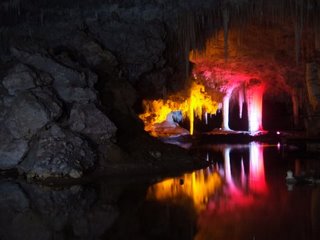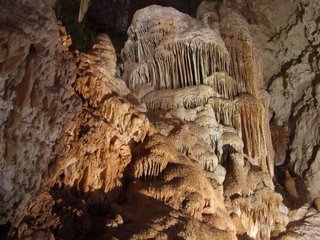Wine and Women and...(3)
 CAVES
CAVESBeneath Margaret River and the whole south west region lie hundreds of limestone caves, most of which are accessible only through very small holes in the ground, which animals and, undoubtedly, the occasional human being, have stumbled upon (and fallen through) from time to time. In one of these caves has been found the skeleton of a Tasmanian Tiger, over 3000 years old. These formations exhibit stalagmite and stalactite growth which reflects tremendous stability in the area for lengthy periods of time (scientists suggests tens – even hundreds – of thousands of years). There is a tranquillity to these caves which invites one to sit and contemplate. Unfortunately most caves offer guided tours which keep you moving, but Mammoth Cave was self-guided, which allowed time and space to appreciate the wonder and beauty before you.
 And there was the occasional window to the surface world – in Jewel Cave one could see the tap root from a Karri tree wound around a pillar (where a stalactite joins with a stalagmite) – and here we were 50 metres below the surface! Karri trees live to around 400 years and grow in excess of 60 metres in height, making its combined length (including tap root) well in excess of 100 metres! It gave pause for thought when the guide indicated that we were underneath the road we had travelled on to arrive at the cave – one wonders what other delights sit below the surface of places we travel! When they turn the lights out in the caves there is complete blackness – not a skerrick of light penetrates these places. Imagine falling through a hole and landing inside! Early cave explorers carried candles which would often be extinguished by drips of water from the ceiling, plunging them into blackness. The experience in many ways defies expression – the magnificence of these underground worlds breathtaking to experience. We were all taken in by these caves, exploring three over successive days.
And there was the occasional window to the surface world – in Jewel Cave one could see the tap root from a Karri tree wound around a pillar (where a stalactite joins with a stalagmite) – and here we were 50 metres below the surface! Karri trees live to around 400 years and grow in excess of 60 metres in height, making its combined length (including tap root) well in excess of 100 metres! It gave pause for thought when the guide indicated that we were underneath the road we had travelled on to arrive at the cave – one wonders what other delights sit below the surface of places we travel! When they turn the lights out in the caves there is complete blackness – not a skerrick of light penetrates these places. Imagine falling through a hole and landing inside! Early cave explorers carried candles which would often be extinguished by drips of water from the ceiling, plunging them into blackness. The experience in many ways defies expression – the magnificence of these underground worlds breathtaking to experience. We were all taken in by these caves, exploring three over successive days.

0 Comments:
Post a Comment
<< Home